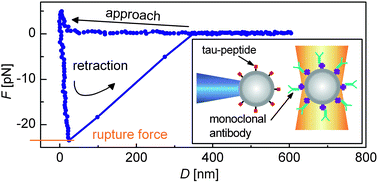Dynamic force spectroscopy on the binding of monoclonal antibodies and tau peptides
Abstract
Optical tweezers-assisted

* Corresponding authors
a
Leipzig University, Department of Experimental Physics I, Linnéstr. 5, Leipzig, Germany
E-mail:
Carolin.wagner@physik.uni-leipzig.de
Fax: +49-341-9732599
Tel: +49-341-9732718
b Leipzig University, Center for Biotechnology and Biomedicine (BBZ), Institute for Bioanalytical Chemistry, Deutscher Platz 5, Leipzig, Germany
Optical tweezers-assisted

 Please wait while we load your content...
Something went wrong. Try again?
Please wait while we load your content...
Something went wrong. Try again?
C. Wagner, D. Singer, O. Ueberschär, T. Stangner, C. Gutsche, R. Hoffmann and F. Kremer, Soft Matter, 2011, 7, 4370 DOI: 10.1039/C0SM01414A
To request permission to reproduce material from this article, please go to the Copyright Clearance Center request page.
If you are an author contributing to an RSC publication, you do not need to request permission provided correct acknowledgement is given.
If you are the author of this article, you do not need to request permission to reproduce figures and diagrams provided correct acknowledgement is given. If you want to reproduce the whole article in a third-party publication (excluding your thesis/dissertation for which permission is not required) please go to the Copyright Clearance Center request page.
Read more about how to correctly acknowledge RSC content.
 Fetching data from CrossRef.
Fetching data from CrossRef.
This may take some time to load.
Loading related content
